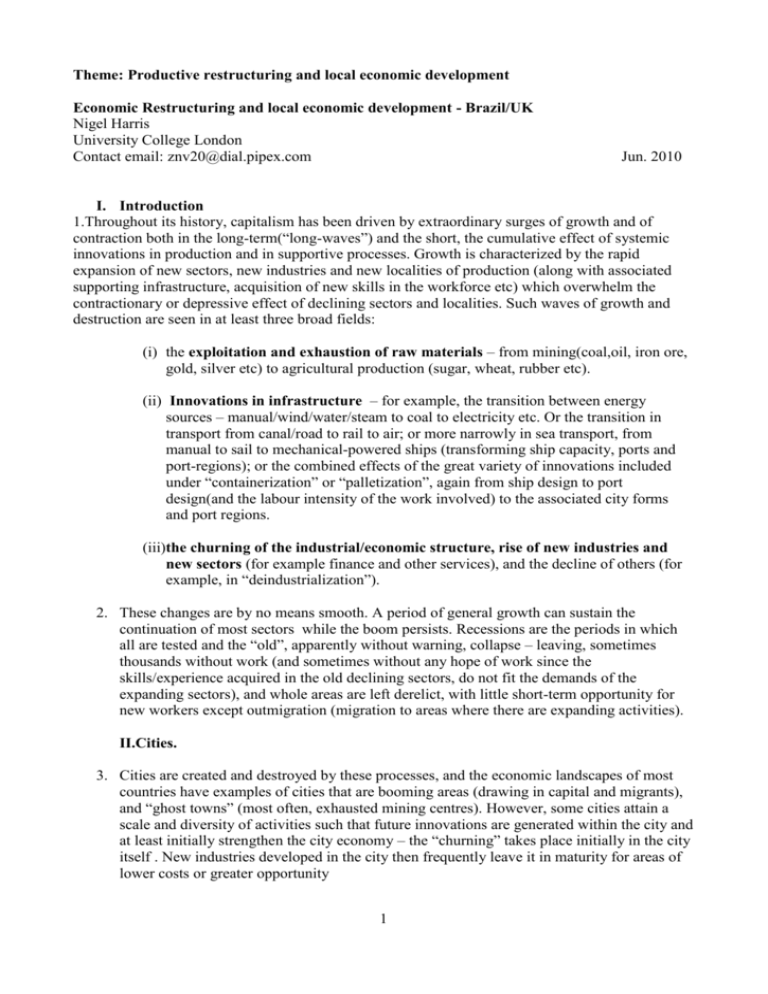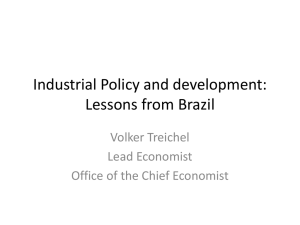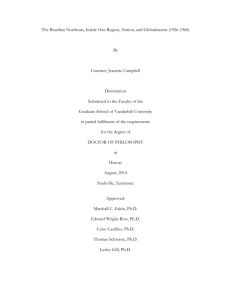Economic Restructuring and local economic development -
advertisement

Theme: Productive restructuring and local economic development Economic Restructuring and local economic development - Brazil/UK Nigel Harris University College London Contact email: znv20@dial.pipex.com Jun. 2010 I. Introduction 1.Throughout its history, capitalism has been driven by extraordinary surges of growth and of contraction both in the long-term(“long-waves”) and the short, the cumulative effect of systemic innovations in production and in supportive processes. Growth is characterized by the rapid expansion of new sectors, new industries and new localities of production (along with associated supporting infrastructure, acquisition of new skills in the workforce etc) which overwhelm the contractionary or depressive effect of declining sectors and localities. Such waves of growth and destruction are seen in at least three broad fields: (i) the exploitation and exhaustion of raw materials – from mining(coal,oil, iron ore, gold, silver etc) to agricultural production (sugar, wheat, rubber etc). (ii) Innovations in infrastructure – for example, the transition between energy sources – manual/wind/water/steam to coal to electricity etc. Or the transition in transport from canal/road to rail to air; or more narrowly in sea transport, from manual to sail to mechanical-powered ships (transforming ship capacity, ports and port-regions); or the combined effects of the great variety of innovations included under “containerization” or “palletization”, again from ship design to port design(and the labour intensity of the work involved) to the associated city forms and port regions. (iii)the churning of the industrial/economic structure, rise of new industries and new sectors (for example finance and other services), and the decline of others (for example, in “deindustrialization”). 2. These changes are by no means smooth. A period of general growth can sustain the continuation of most sectors while the boom persists. Recessions are the periods in which all are tested and the “old”, apparently without warning, collapse – leaving, sometimes thousands without work (and sometimes without any hope of work since the skills/experience acquired in the old declining sectors, do not fit the demands of the expanding sectors), and whole areas are left derelict, with little short-term opportunity for new workers except outmigration (migration to areas where there are expanding activities). II.Cities. 3. Cities are created and destroyed by these processes, and the economic landscapes of most countries have examples of cities that are booming areas (drawing in capital and migrants), and “ghost towns” (most often, exhausted mining centres). However, some cities attain a scale and diversity of activities such that future innovations are generated within the city and at least initially strengthen the city economy – the “churning” takes place initially in the city itself . New industries developed in the city then frequently leave it in maturity for areas of lower costs or greater opportunity 1 4. These processes – of economic churning - are as old as the city itself, but with the accelerated economic development of the twentieth century have become very much more rapid and all-encompassing in our own times. Now whole regions – for example, the Pearl river delta region in China – can be transformed in two decades, alongside the equally rapid destruction of old industrial regions such as the Ruhr, the mid-west steel producing and using cities in the US (Gary to Pittsburgh, including Detroit), the north-east Lancashire and the west Midlands in the UK. The destruction of old port areas and regions in the twentieth century has notoriously been equally dramatic – in Baltimore and Manhatten, London, Rotterdam, Cape Town, Sydney, Yokohama etc. 5. These processes have produced some dramatic examples of at least short-term collapse in which it seemed recovery was almost impossible to achieve – as in New York in 1975/76, or less dramatically, most older industrial cities in Europe and North America; some possible candidates for zombie status (in Lant Pritchett's terms), as with Detroit; and some examples of dramatic rehabilitation (of which Barcelona is one among many examples). On the other hand, lessons from this process - particularly, in the stages of economic evolution of Singapore and other cases have provided a menu of the economic activities supposedly required in the modern city for newcomers (for example, in Dubai) – a financial centre, a container port, culture and sports centre, higher education and advanced medical centres etc., so that a city supposedly acquires a diversity capable of riding future waves of growth and contraction without suffering the losses experienced in specialized cities (as with Detroit). III Local Economic development 6. City authorities have been intervening to facilitate and spur local economic growth for as long as cities and trade have existed, and the rich experience in Europe and north America over the past two decades in transforming their city economies is only a recent part of the story, heightened because it comes at the end of a century of, at least in Europe, high administrative centralization, in which the local was most often superseded by national government. A degree of local administrative autonomy is, it hardly needs saying, a necessary precondition for any locally-initiated development. Due to that degree of centralization, British local government, unlike local Chambers of Commerce, up until the major urban crisis of the 1970s rarely needed to interest itself in the local economy. That was transformed by the crisis, and generally since then there has been an immense expansion in analysing and monitoring the city economy, in facilitating economic – and now environmental – initiatives. In the case of Brazil, given the severe problems of economic development (unlike the British case) there has been much more close attention to the regional city economies – particularly, while regional Planning authorities functioned, in Sâo Paolo with Emplasa and in Recife, Salvador etc. However, there is a striking difference since Brazilian planning was directed at managing extraordinary and sustained economic growth, British city economic planning was focused on managing contraction, on changing the basis of the city economy, in particular coping with deindustrialization and the end of the nineteenth century city economy. 7. What can city authorities do to assist city economic development? Although major public infrastructure projects have been important in stimulating city economic growth, it is more frequent that innovations in private business create new sectors and industries and open up new localities to development. Local government has an important role here in: 2 (a) adjusting local regulations to support growth; (b)providing – or stimulating the provision - of new infrastructure (water, power, transport) to support such growth; (c) if appropriate (ie in the division of local/national powers) reshaping the city educational and training system to expand the creation of an appropriately qualified workforce and support local research; (d) promoting the city's innovations – lobbying the national government for support (especially where external trade is important to the new industry), arranging exhibitions and trade fairs, twinning relevant cities etc. 8. However, there is a broader role for those who provide leadership in the city, public, private and voluntary, in seeking to pull together all the diverse threads of the city's economic activity in a common vision for the city's future, combining realistic financial scenarios, a perspective plan projecting the city's future requirements, and an environmental strategy to protect and improve the city. This requires continuous monitoring of city activity and stimulating research on the city. In essence, this was the core of the proposals for City Development Strategies (City Alliance). IV. The future. 9. It is of course, impossible to suggest the likely trends in urban restructuring of cities, their economic decay and refurbishing (in some cases, decline and disappearance). But based upon the speed of change, the transformation of cities and their regions in the past half century, we can expect not to be able to recognize now familiar cities in fifty years time. The unknowables in the equation also include “sustainability”, how far can present trends be sustained, both in the light of projected environmental scenarios and threats, and in terms of the regulatory and technological innovations resulting from these threats. We can only list some of the issues for possible consideration: i) what is the viability of current high growth patterns(in, for example, China and Brazil) and what are the spatial implications? Will deindustrialization set in the foreseeable future, and how will this affect other regions(particularly Africa)? ii)migration and the creation of a global labour market – the end of national selfsufficiency in labour and skills? ii)what are the implications of the globalization of services – in particular, education and health services. iv)Will cities and city region retain their fundamental role in world growth? Urban dispersal (metropolitanization) versus concentration. v) is a global social structure emerging and what are the implications for national political power and local governance? v) What are to be the forms of (a) the continued attack on world poverty and (b) the fearful effects of unmanaged economic growth? V. Comparative work 10. Research concerning deindustrializatiuon between Brazil and UK is difficult particularly because of the different economic histories – Brazil appears to be on a rising crescendo of industrialization, Britain is possibly at the end of more than a century of manufacturing decline from its pre-eminence in about 1870. However, this does nor rule out Brazilian deindustrialization as a number of writers have argued – and certainly, in locality terms, the threat to the ABC districts of São Paulo by the continued expansion of vehicle manufacture 3 in east Asia is more substantial1. However, this is unfortunately likely to be almost completely speculative. 11. On the other hand, to narrow the focus drastically – to the redevelopment of port cities – might allow much more specific conclusions. In both Brazil and UK, the rise of new container ports outside the port regulatory authority (in particular, Felixstowe in UK) threatened to bankrupt major historic ports (London's Tilbury in UK, and Santos and Recife in Brazil), forcing the decontrol of port activity, but with resulting heavy physical damage to the associated urban fabric, the city region, as well as the inherited labour force. Other ports – Recife, Liverpool, Southampton) – might tell variations on the main theme. However, the interest here is in how city and city regional authorities reacted to an economic catastrophe of the size, and with what success in creating an alternative economic basis for the city. 1 And perhaps, even more substantial, the threat to the Novo Hamburgo's footwear manufacture from Taiwanese companies in Fujian province in China. 4








